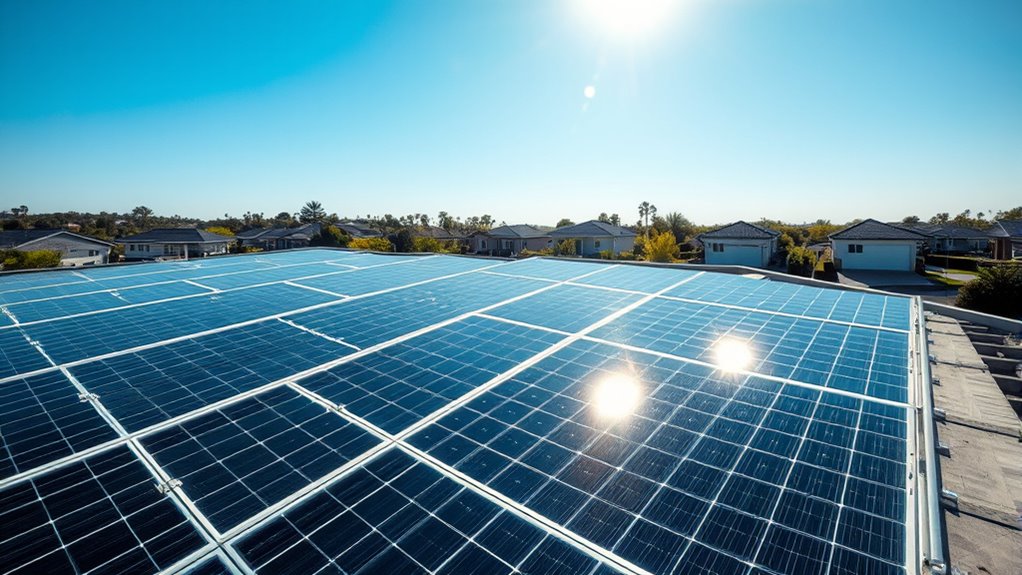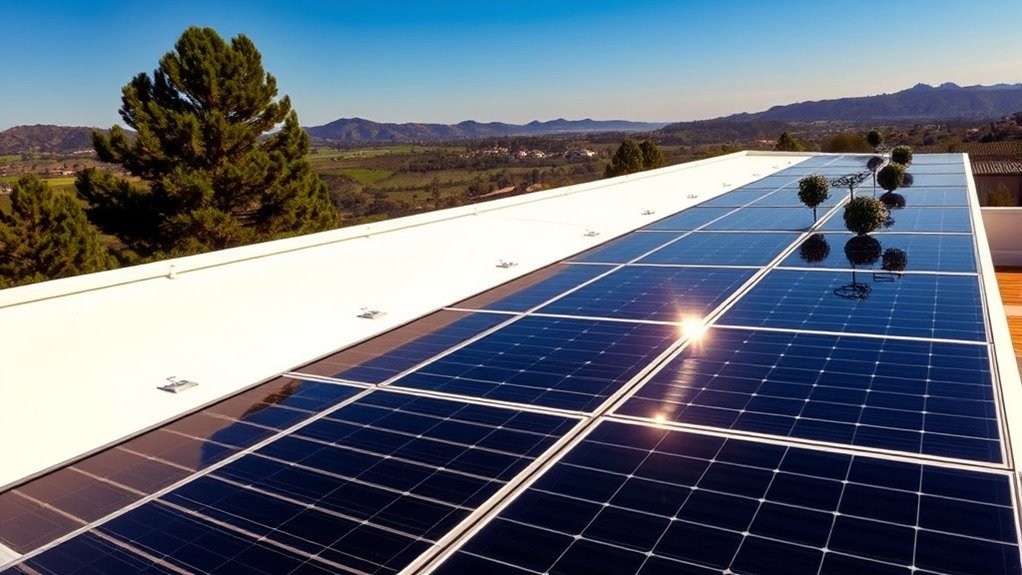By 2025, solar panels have become more affordable than ever, thanks to falling costs, innovative manufacturing, and government incentives. With prices dropping markedly and financing options available, you can now install a residential system at a much lower out-of-pocket expense. Plus, regional rebates and tax credits boost your savings. With minimal maintenance and the addition of battery storage, solar is a smart, cost-effective choice for your home—if you want to see how to maximize your benefits, keep going.
Key Takeaways
- Solar panel costs have significantly decreased, with average prices dropping to around $3/watt by 2025.
- Federal tax credits and regional rebates can reduce overall costs by up to 30% or more.
- Innovative financing options, including low-interest loans, make solar installations more affordable with manageable payments.
- Advances in battery storage technology enhance energy independence and maximize savings.
- Ongoing technological improvements and regional incentives continue to drive down costs and improve affordability.

Solar Panels 2025 – Finally Affordable for Your Home?
Solar Panels 2025 – Finally Affordable for Your Home?
As 2025 approaches, solar panels become more affordable and accessible than ever before. You might have thought solar energy was out of reach due to high upfront costs, but recent trends show a different story. The national average cost for installing residential solar has dropped from about $7.50 per watt in 2010 to roughly $3 per watt in 2025, mainly thanks to manufacturing improvements and economies of scale. This substantial reduction means your initial investment is now much lower, especially when combined with federal tax credits that can cut costs by around 30%. With these incentives, a typical 11 kW system now costs about $19,404 nationwide after credits, and your actual out-of-pocket expense could be even less depending on regional rebates and incentives.
You might wonder how to finance this investment. Solar financing options, such as solar loans, have become increasingly popular, offering low-interest rates and manageable monthly payments. These payments are often lower than your current electricity bills, making solar both a smart financial move and a way to lock in predictable energy costs. Plus, many lenders now include maintenance costs in their packages or offer flexible plans that cover routine solar system upkeep. This makes managing your solar investment simpler while ensuring your system remains efficient over its lifespan.
Speaking of maintenance, solar systems require minimal upkeep, especially with modern, durable panels. Routine checks, occasional cleaning, and monitoring system performance can keep your panels operating at peak efficiency for decades. Since solar technology has advanced, panels are now more resistant to weather, dirt, and wear. The stability in panel prices—expected to fluctuate only 5-10% in 2025—means you can confidently plan for upcoming maintenance without unexpected costs. Additionally, integrating battery storage, which has seen a 75% price drop over the past 15 years and now costs around $200-$400 per kWh, can further boost your system’s value. With batteries, you can store excess solar energy to power your home during cloudy days or at night, maximizing savings and independence. Ongoing technological innovations continue to improve efficiency and reduce costs, making solar an even more attractive option.
While costs for panels and batteries are stabilizing, ongoing research and development promise even cheaper, easier-to-manufacture solutions in the future. This ongoing innovation, combined with the current affordability of solar financing and low maintenance needs, makes solar energy a practical choice for your home today. As you consider shifting to solar, remember that regional differences and incentives can considerably influence total costs and savings. Recent technological advancements have further lowered manufacturing costs, making solar panels more affordable than ever. By leveraging local rebates, federal tax credits, and flexible financing options, you’re positioned to enjoy the benefits of cleaner energy and lower utility bills for years to come.
Frequently Asked Questions
Will Government Incentives Still Be Available in 2025?
You wonder if government incentives will still be available in 2025. Currently, the 30% federal solar tax credit is set to expire at the end of 2025 due to policy changes, with no plans for renewal. While incentives have helped make solar more affordable, future support depends on legislative action. Keep an eye on policy changes, as they could affect the availability of government incentives for your solar projects beyond 2025.
How Long Do Solar Panels Typically Last?
Think of solar panels as reliable old friends that stand the test of time. Typically, their lifecycle expectations range from 25 to 30 years, depending on durability factors like quality, weather, and maintenance. While they gradually lose efficiency, most still produce enough energy during their prime years. Proper installation and care can help them last closer to 30 years, making them a long-term investment for your home’s energy needs.
Are There Any Hidden Costs With Installing Solar Panels?
You should watch out for hidden fees and installation surprises when installing solar panels. These can include costs for roof repairs, structural upgrades, permits, and inspections that aren’t clear upfront. Optional equipment like batteries or smart monitors add to expenses. Also, keep in mind ongoing costs for maintenance or inverter replacements. Being aware of these potential hidden fees helps you plan your budget better and avoid unpleasant surprises during the process.
Can I Install Solar Panels Myself or Need a Professional?
Trying to DIY install solar panels can feel like scaling Mount Everest—impressive but risky if you’re unprepared. You might save money, but it’s best to know that DIY installation often requires contractor requirements, especially for electrical and roofing work. Handling wiring, mounting panels, and safety precautions demands skills, tools, and permits. For a safe, efficient system, consider professional help or a hybrid approach to meet all regulations and guarantee maximum performance.
What Maintenance Is Required to Keep Panels Efficient?
To keep your panels efficient, follow cleaning routines like inspecting every 3 to 6 months and washing with a soft brush and soapy water, especially in dusty areas. Use efficiency tips such as monitoring your system regularly to catch performance drops early. Avoid abrasive cleaners, and clean panels early in the morning with cold water to prevent thermal shock. Regular checks help maintain peak energy production and extend your system’s lifespan.
Conclusion
By 2025, solar panels could finally be affordable for your home, transforming your energy costs. Imagine slashing your bills while contributing to a greener planet—it’s a win-win. Yet, as prices drop, the choice becomes more complex: will you seize this chance or wait? The future’s bright, but only if you decide to harness the sun now. Don’t let this opportunity slip away—solar power is within your reach, and it’s more accessible than ever.










